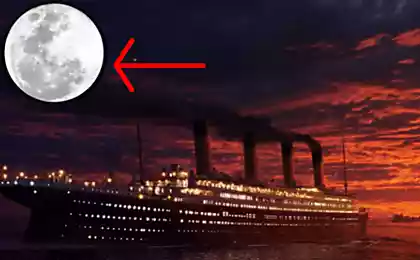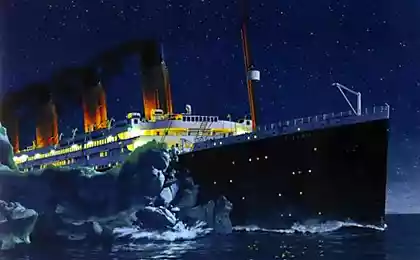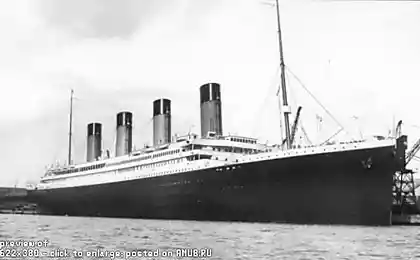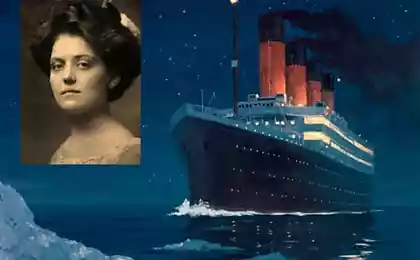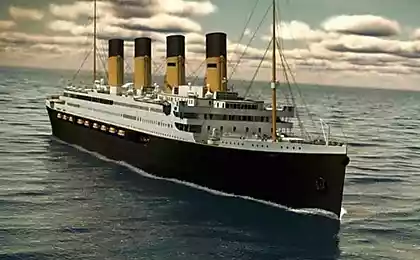1059
Titanic. 101 years at the bottom (44 photos)
On the night of September 1, 1985 American-French expedition led by oceanographer Robert Ballard found at the bottom of the Atlantic Ocean Titanic steam boiler. Soon, the remains were found, and the ship itself. Thus ended the long-standing saga of searching the sunken ship, which was carried out by several independent researchers, but for a long time, was unsuccessful due to incorrect coordinate loss of the vessel, of broadcast fateful night in 1912 Discovery of the remains of the Titanic has opened a new page in its history, became known the answers to Many contentious issues; a number of facts that were considered proven and irrefutable, were wrong.
First intention to find and raise the Titanic appeared immediately after the disaster. Families few millionaires would find the bodies of their dead relatives to bury them properly, and discussed the issue of raising the Titanic with one of the firms specializing in underwater rescue operations. But while the technical capability to carry out such an operation was not. They also discussed a plan to lose on the ocean floor dynamite charges to explosions on the surface to pick up some of the body, but also on the intentions of eventually abandoned.
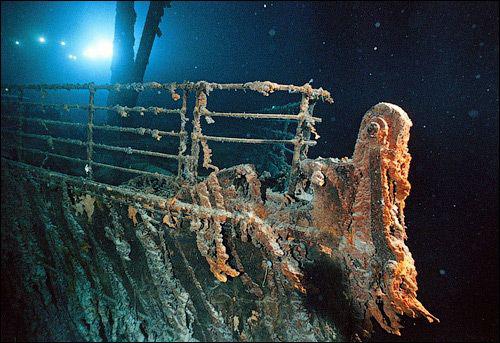
later I developed a whole series of crazy projects raising the Titanic. For example, asked to fill hull pingpongovymi balls or attach to it with helium balloons, which lift it to the surface. There were many other projects, mainly fiction. Also, before you try to raise the Titanic had to be first to find, and this was not so simple.
One of the controversial issues in the history of the Titanic for a long time remained coordinates broadcasted along with the distress call. They identified a fourth mate Joseph Boxhall based on the coordinates that have been calculated for a few hours before the collision, the speed and course of the vessel. Check them in detail to the environment has not been, and Carpathia, which came a few hours to help, successfully went to the boats, but the first doubts about the correctness of origin has arisen during the investigation 1912 At the time, the issue is still open and when in the 80's began the first serious attempt to find the Titanic, the researchers faced a problem: the Titanic was not in the specified coordinates, or next to them. The situation is complicated and the local conditions of the disaster - because the Titanic was at a depth of about 4 km and to find the appropriate equipment needed.
At the end luck Robert Ballard, who step by step, preparing for the expedition almost 13 years. After nearly two months of searching, when the end of the expedition was only 5 days and Ballard had already begun to doubt the success of the event, on the monitor connected to the video camera on the descent deep-water apparatus shown some strange shadows. It was almost one in the morning September 1, 1985 It soon became clear that it is nothing like the wreckage of a ship. After a while I found one of the boilers and doubt that owned the Titanic wreckage, left. The next day was found front hull part. Big surprise was the absence of the stern: after an investigation in 1912 Officially, the ship sank completely.
The first expedition Ballard gave answers to many questions, and gave the world a number of contemporary photographs of the Titanic, but much still remains unclear. A year later, Ballard again went to the Titanic, and in this expedition has already been applied landing deep-sea vehicle that could deliver on the ocean floor three. There was also a small robot, which allowed to carry out research within the vessel. This expedition has brought clarity to many issues that remained open since 1912 and after Ballard is no longer planned to return to the Titanic. But that did Ballard, others have done and soon reached New Titanic expedition. Some of them were purely exploratory in nature, some were aimed at lifting the bottom of the various items, including and for sale at auction, triggering a lot of scandals about the moral and ethical side of the issue. By repeatedly Titanic went down, and James Cameron; not only for the shooting of his film in 1997, but also for research using robotics in the vessel (see. the documentary "Ghosts of the Abyss"), whereby it was opened many new facts about the condition of the vessel and its once magnificent finish.
With regard to lifting the Titanic, Ballard's expedition after it became clear that this operation will not just be arhilegkoy and expensive; hull long been in such a state that simply fall apart, if not during the ascent, on the surface.
1. Let's see how the Titanic looks like today, and looked like before. Titanic sank in the Atlantic at a depth of nearly 4 km. During diving vessel broke in two pieces, which now lie at the bottom of approximately six hundred meters apart. Around them are scattered a lot of debris and objects, including and a pretty big piece of Titanic's hull.
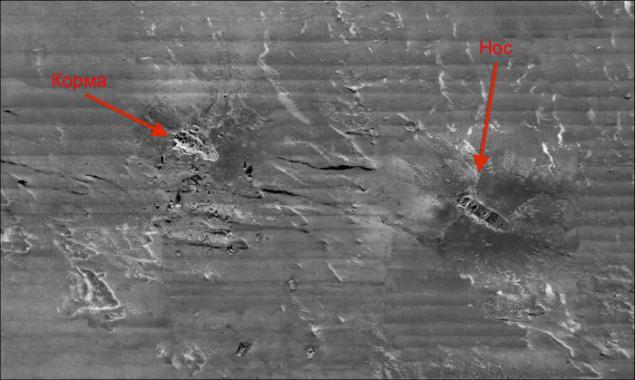
2. Model bow. Nose in the fall to the bottom of the vessel is very well buried in the silt, which greatly disappointed the first researchers to inspect the scene after hitting the iceberg without special equipment was impossible. Torn hole in the body, which can be seen on the model, formed from the impact on the bottom.
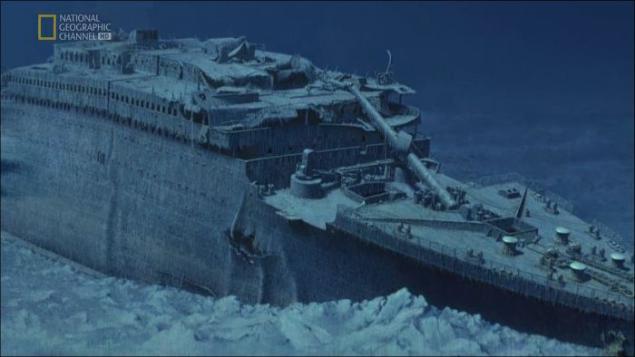
3. Map the bow assembled from several hundred images. From left to right: just above the edge of the nose sticks spare anchor winch, it is for the mooring device, immediately followed by an open hatch into the hold №1, from which diverge to the sides of the line of the breakwater. Mezhnadstroechnoy On deck is a fallen mast, beneath are two hatches in the holds and winches for use with load. In front of the main superstructure it was once the bridge that collapsed during the fall to the bottom and now is now only a guess on specific details. Over the bridge is preserved superstructure cabin officers, Captain, radio room, and so on., Which crosses the crack formed on the site of the expansion joint. The gaping hole in the superstructure - the first place in the chimney. Just behind the superstructure can see another hole - it is a well, which was a staircase. Located to the left of something very torn - there was a second tube.

4. Nose Titanic. Most bayanny of underwater photographs of the vessel. At the end of the loop can be seen, which was put on the rope that held the mast.
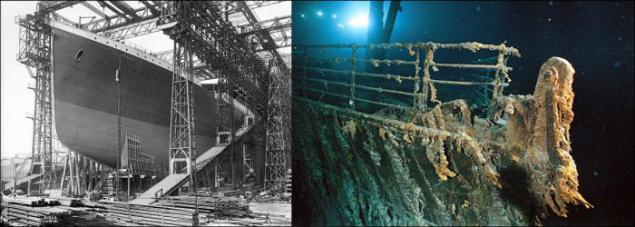
5. On the left can be seen towering over the spare anchor winch nose.
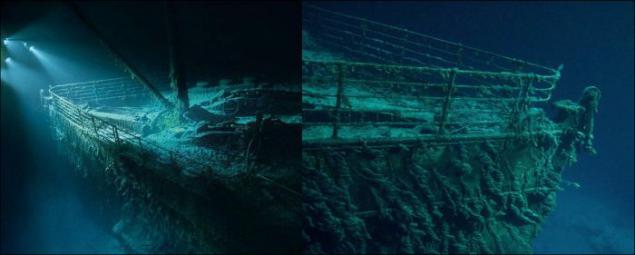
6. Main anchor the left side. Surprisingly, it does not fall down when hitting the bottom.
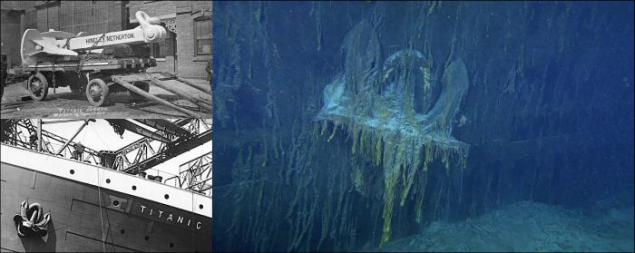
7. Spare anchor:
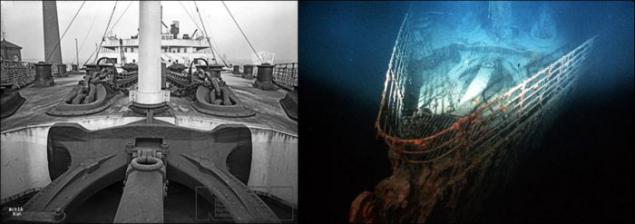
8. During the spare anchor mooring system is:
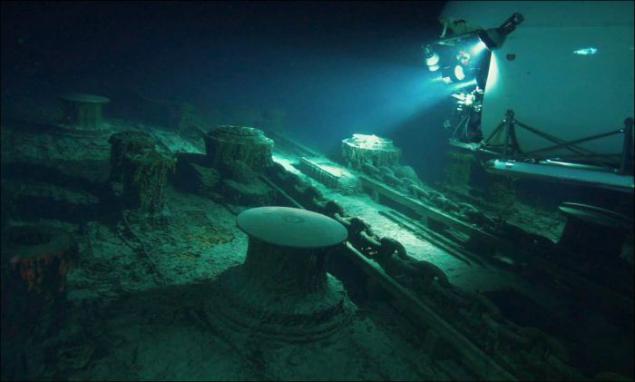
9. Open the hatch in the cargo hold №1. The lid flew off to the side, apparently, with the impact on the bottom.

10. On the mast used to be the remains of "crow's nest", where there were lookouts, but ten or twenty years ago, they have fallen off and is now down about the "crow's nest" recalls only the hole in the mast through which lookouts fell on a spiral staircase. Tail sticking out of the hole - fixing the ship's bell.
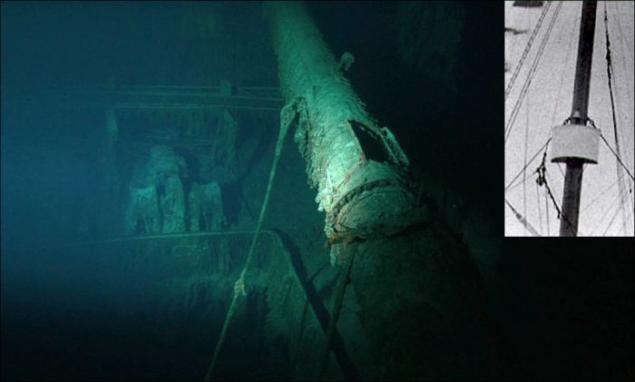
11. On-board ship:
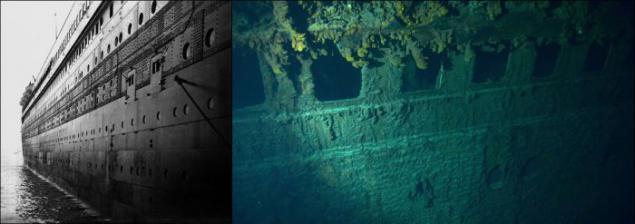
12. From the bridge there was only one of the steering wheels.
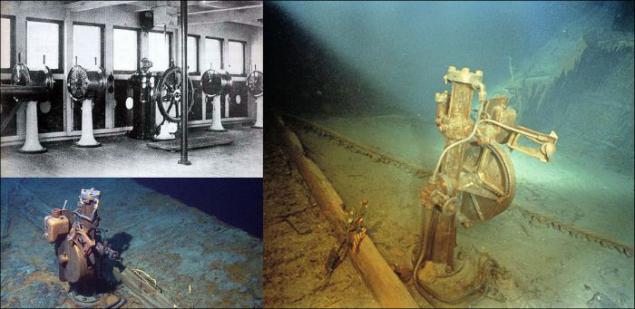
13. The boat deck. The add-on it in some places or uprooted or broken.
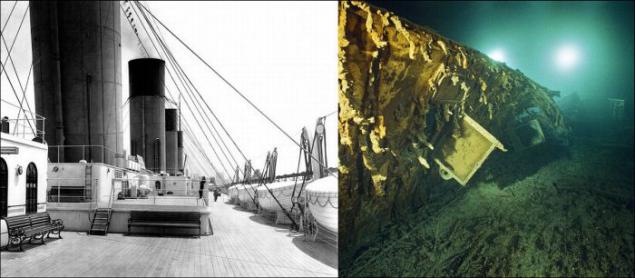
14. The remains of the superstructure at the front of the deck. Bottom right - the entrance to the main staircase 1st class.
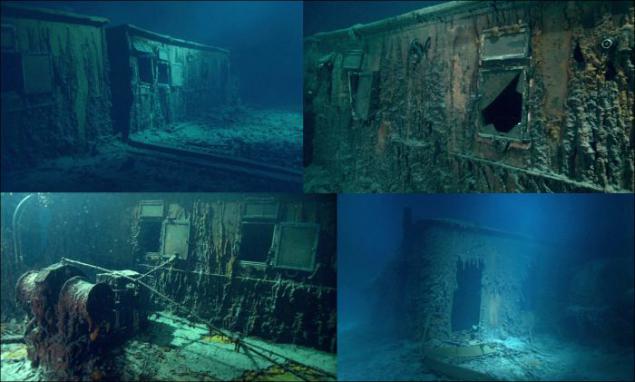
15. Surviving davits, bath cabin Captain Smith and the remains of the ship's whistle, which was installed on one of the pipes.
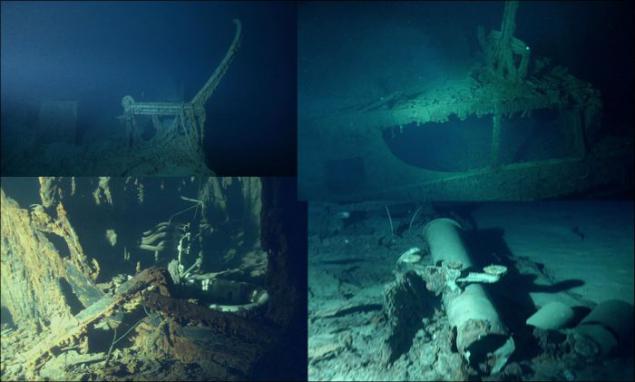
16. In place of the grand staircase is now a huge gaping pit. No trace of the stairs did not survive.
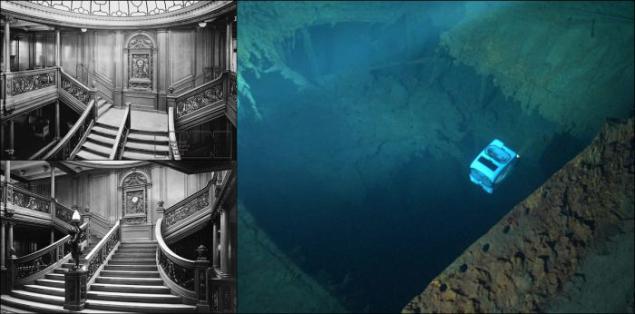
17. Stairway to 1912 .:
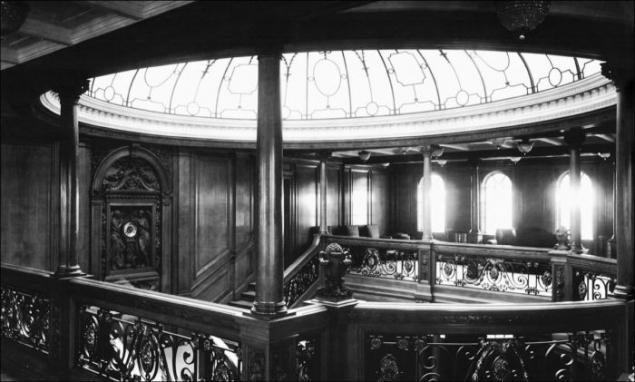
18. And the same view today. Looking at the previous photo is somehow hard to believe that this is the same place.
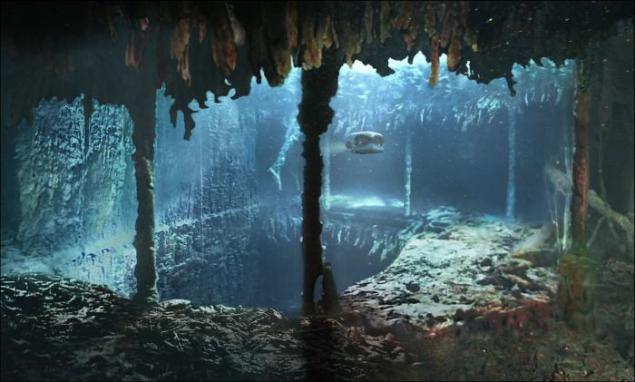
19. staircase housed several elevators for passengers 1st class. They are kept separate elements. The inscription, illustrated below right, was placed in front of elevators and designated the deck. This inscription belonged deck A; bronze letter A has fallen off, but traces of it remain.
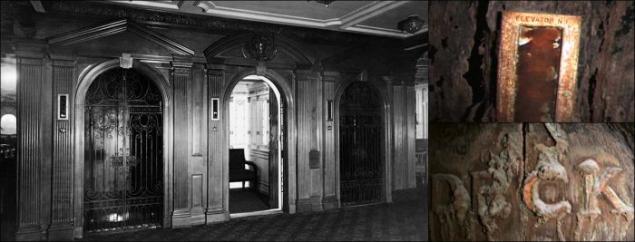
20. Hall 1st class on the deck D. This lower part of the grand staircase.
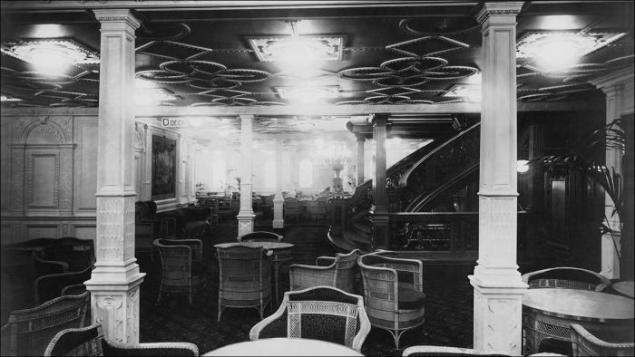
21. While almost all the wood trim vessel have long been eaten by microorganisms, are some elements still exist.
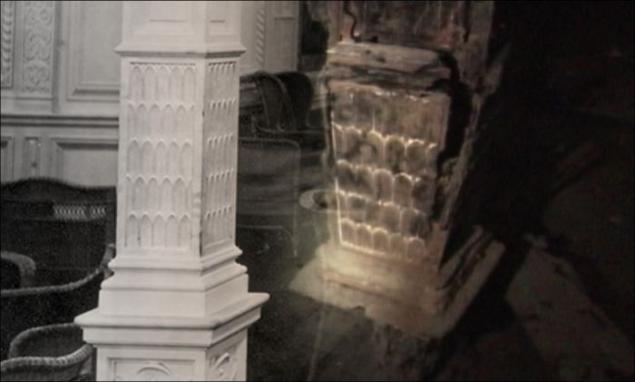
22. Restaurant and lounge 1st class on the deck D was separated from the outside world large stained-glass windows, which have been preserved to this day.
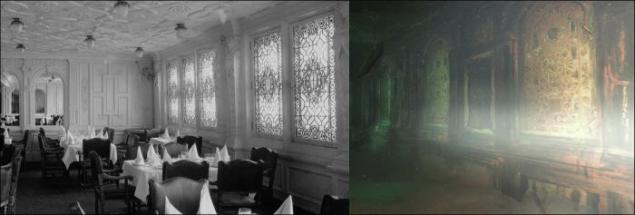
23. The remains of former beauty:
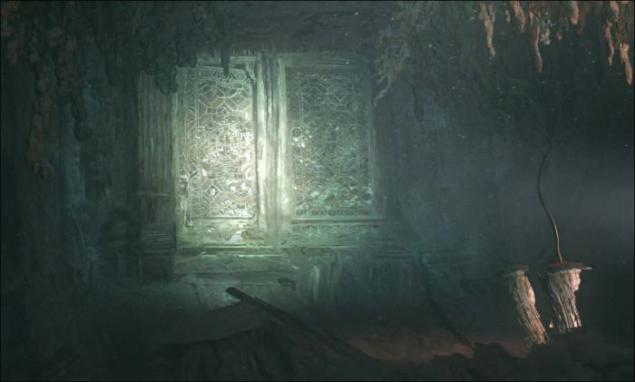
24. Outside the window guessed from the characteristic double portholes.
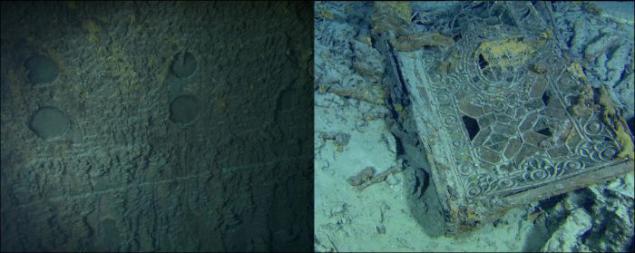
25. Elegant chandeliers and hang in place for over 100 years.

26. The once magnificent interiors cabins 1st class is now covered with debris and rubble. In some places you can find preserved pieces of furniture and objects.
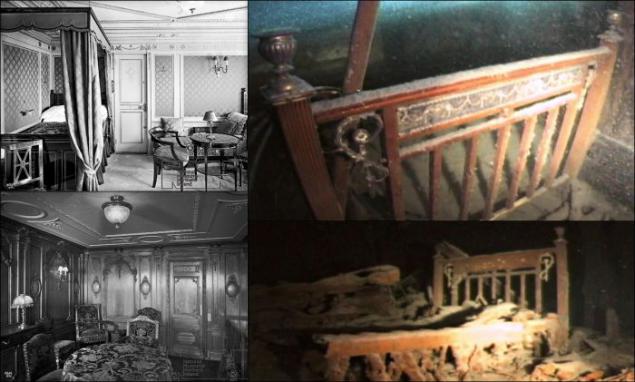
27.
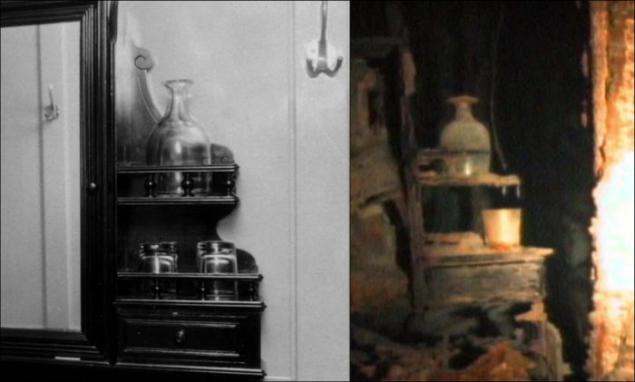
28.
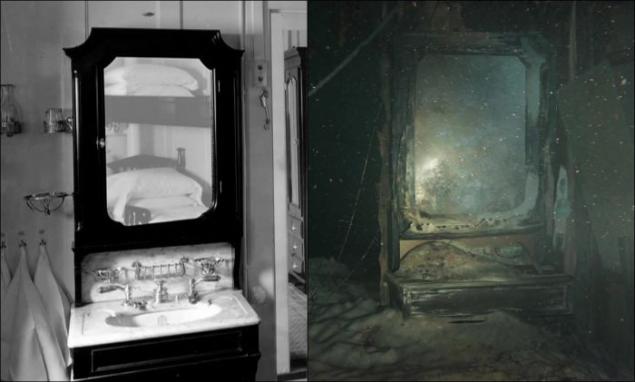
29. A little more detail. The door to the restaurant on the deck D and plaque designating the service door:
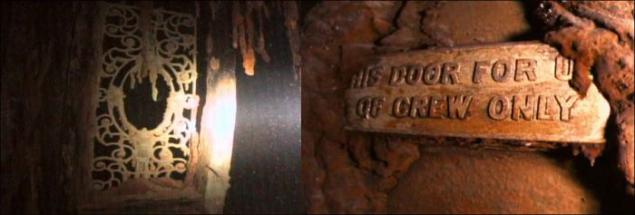
30. At the firemen had a "grand staircase". In order not to meet with the passengers from the cabins to the boiler firemen kept separate staircase.
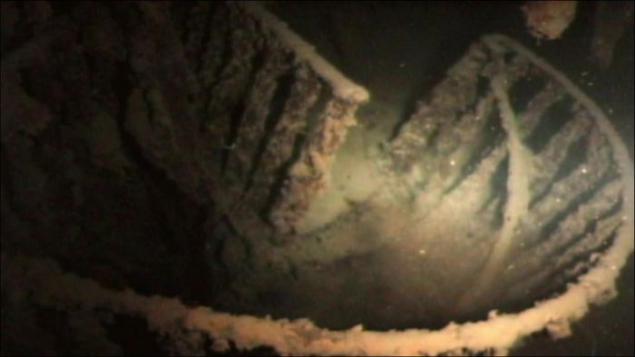
31. As the ocean floor scattered hundreds of items, ranging from parts of the vessel and ending with the personal belongings of passengers.
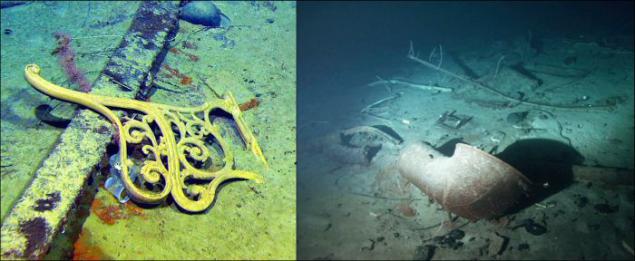
32. Several pairs of shoes lay in a very typical situation: for some it is a place became grave.
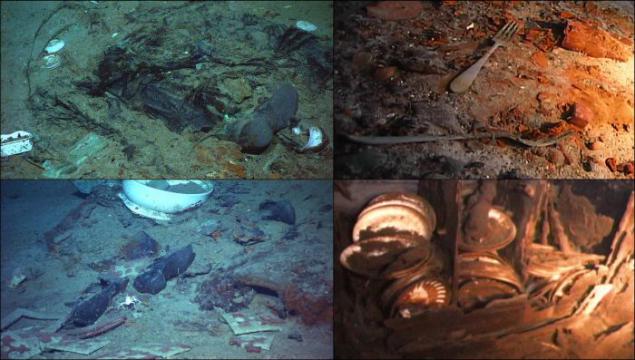
33. The personal belongings and items scattered on the bottom and large parts of skin, which also tried repeatedly to raise to the surface.

34. If the nose is preserved in more or less good condition, the aft part after falling down became a heap of metal. Starboard:
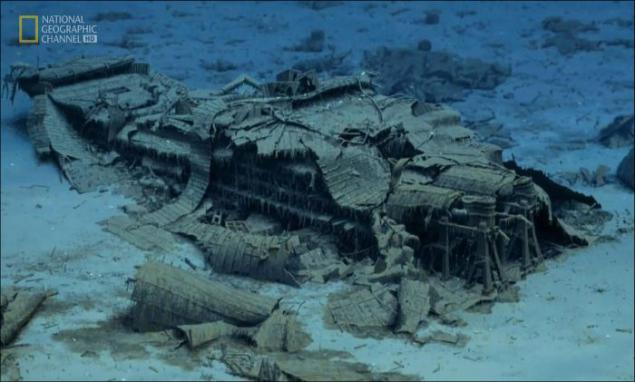
35. The left side:
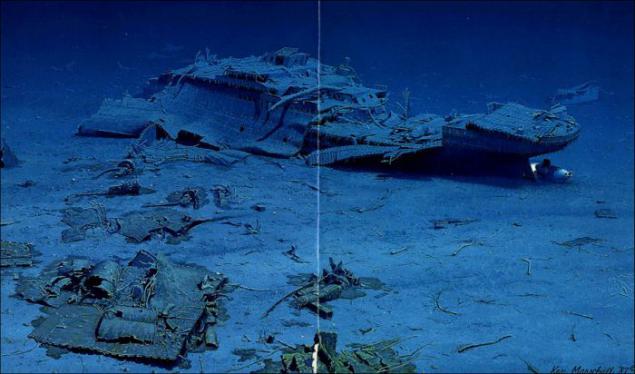
36. Feed:
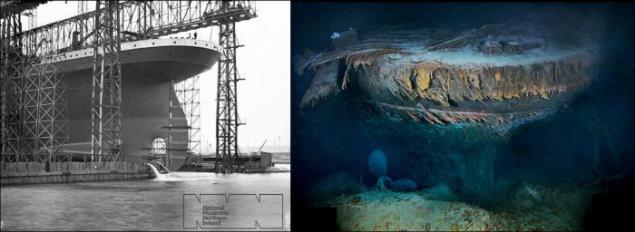
37. On the promenade deck of the 3rd class barely discern the individual details of the vessel.
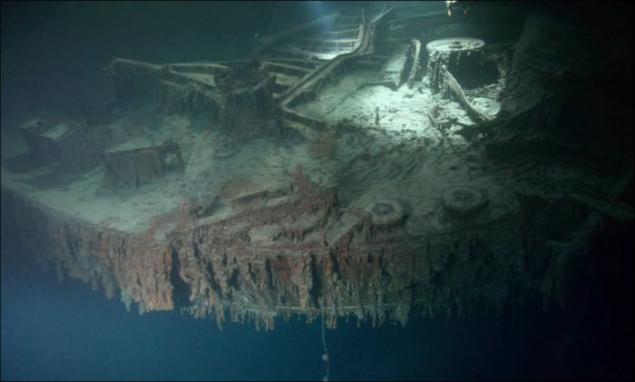
38. One of the three enormous propellers:
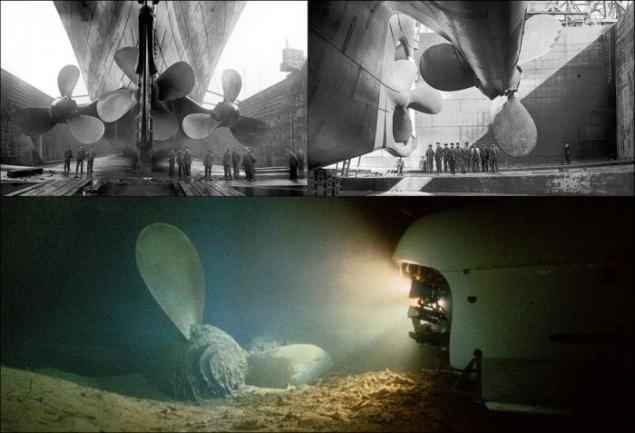
39. After breaking the ship in two parts at the bottom of spilled even steam boilers.
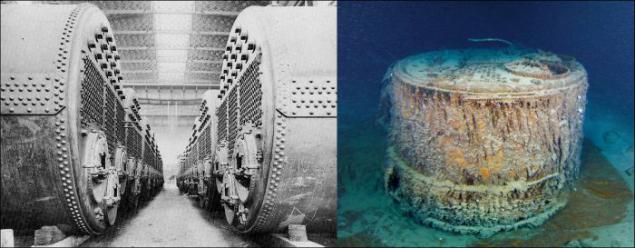
40. At the point of fracture was just the engine room and now these giants as tall as a three-storey house available eyes of researchers. The piston unit:
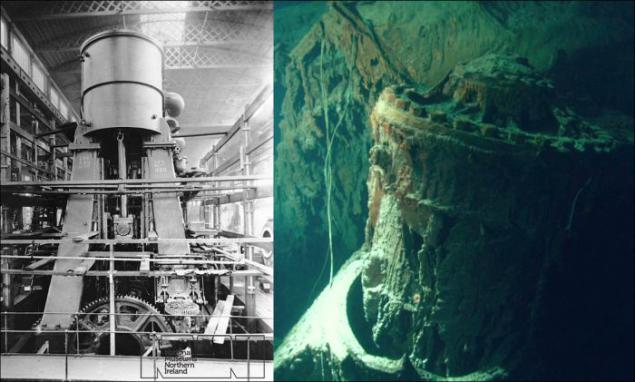
41. The two steam engines together:
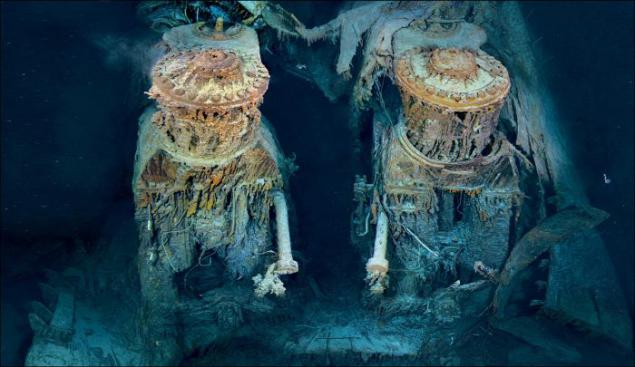
42. Dry Dock in Belfast, which was carried out final painting of the hull, still exists today as a museum exhibit.
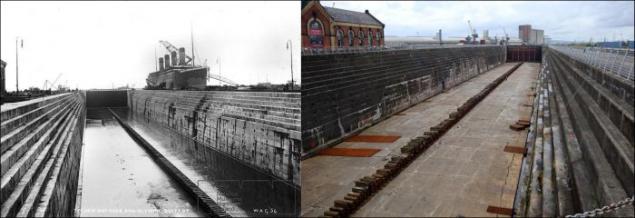
43. And so would look like "Titanic" on the background of the biggest passenger liner modern «Allure of the Seas», commissioned in 2010 .:

Comparison at a Glance:
- Displacement «Allure of the Seas» 4 times greater than that of "Titanic»;
- The length of a modern airliner of 360 m (100 m more than the Titanic);
- Maximum width of 60 m to 28, the "Titanic»;
- Draft about the same (about 10 m);
- Speed is also almost the same (22-23 nodes);
- The number of teams - 2, 1 thousand. People ("Titanic" was up to 900, many of whom were stokers);
- Seating capacity - up to 6, 4 ths. People (on the Titanic 2, 5 ths.).
First intention to find and raise the Titanic appeared immediately after the disaster. Families few millionaires would find the bodies of their dead relatives to bury them properly, and discussed the issue of raising the Titanic with one of the firms specializing in underwater rescue operations. But while the technical capability to carry out such an operation was not. They also discussed a plan to lose on the ocean floor dynamite charges to explosions on the surface to pick up some of the body, but also on the intentions of eventually abandoned.

later I developed a whole series of crazy projects raising the Titanic. For example, asked to fill hull pingpongovymi balls or attach to it with helium balloons, which lift it to the surface. There were many other projects, mainly fiction. Also, before you try to raise the Titanic had to be first to find, and this was not so simple.
One of the controversial issues in the history of the Titanic for a long time remained coordinates broadcasted along with the distress call. They identified a fourth mate Joseph Boxhall based on the coordinates that have been calculated for a few hours before the collision, the speed and course of the vessel. Check them in detail to the environment has not been, and Carpathia, which came a few hours to help, successfully went to the boats, but the first doubts about the correctness of origin has arisen during the investigation 1912 At the time, the issue is still open and when in the 80's began the first serious attempt to find the Titanic, the researchers faced a problem: the Titanic was not in the specified coordinates, or next to them. The situation is complicated and the local conditions of the disaster - because the Titanic was at a depth of about 4 km and to find the appropriate equipment needed.
At the end luck Robert Ballard, who step by step, preparing for the expedition almost 13 years. After nearly two months of searching, when the end of the expedition was only 5 days and Ballard had already begun to doubt the success of the event, on the monitor connected to the video camera on the descent deep-water apparatus shown some strange shadows. It was almost one in the morning September 1, 1985 It soon became clear that it is nothing like the wreckage of a ship. After a while I found one of the boilers and doubt that owned the Titanic wreckage, left. The next day was found front hull part. Big surprise was the absence of the stern: after an investigation in 1912 Officially, the ship sank completely.
The first expedition Ballard gave answers to many questions, and gave the world a number of contemporary photographs of the Titanic, but much still remains unclear. A year later, Ballard again went to the Titanic, and in this expedition has already been applied landing deep-sea vehicle that could deliver on the ocean floor three. There was also a small robot, which allowed to carry out research within the vessel. This expedition has brought clarity to many issues that remained open since 1912 and after Ballard is no longer planned to return to the Titanic. But that did Ballard, others have done and soon reached New Titanic expedition. Some of them were purely exploratory in nature, some were aimed at lifting the bottom of the various items, including and for sale at auction, triggering a lot of scandals about the moral and ethical side of the issue. By repeatedly Titanic went down, and James Cameron; not only for the shooting of his film in 1997, but also for research using robotics in the vessel (see. the documentary "Ghosts of the Abyss"), whereby it was opened many new facts about the condition of the vessel and its once magnificent finish.
With regard to lifting the Titanic, Ballard's expedition after it became clear that this operation will not just be arhilegkoy and expensive; hull long been in such a state that simply fall apart, if not during the ascent, on the surface.
1. Let's see how the Titanic looks like today, and looked like before. Titanic sank in the Atlantic at a depth of nearly 4 km. During diving vessel broke in two pieces, which now lie at the bottom of approximately six hundred meters apart. Around them are scattered a lot of debris and objects, including and a pretty big piece of Titanic's hull.

2. Model bow. Nose in the fall to the bottom of the vessel is very well buried in the silt, which greatly disappointed the first researchers to inspect the scene after hitting the iceberg without special equipment was impossible. Torn hole in the body, which can be seen on the model, formed from the impact on the bottom.

3. Map the bow assembled from several hundred images. From left to right: just above the edge of the nose sticks spare anchor winch, it is for the mooring device, immediately followed by an open hatch into the hold №1, from which diverge to the sides of the line of the breakwater. Mezhnadstroechnoy On deck is a fallen mast, beneath are two hatches in the holds and winches for use with load. In front of the main superstructure it was once the bridge that collapsed during the fall to the bottom and now is now only a guess on specific details. Over the bridge is preserved superstructure cabin officers, Captain, radio room, and so on., Which crosses the crack formed on the site of the expansion joint. The gaping hole in the superstructure - the first place in the chimney. Just behind the superstructure can see another hole - it is a well, which was a staircase. Located to the left of something very torn - there was a second tube.

4. Nose Titanic. Most bayanny of underwater photographs of the vessel. At the end of the loop can be seen, which was put on the rope that held the mast.

5. On the left can be seen towering over the spare anchor winch nose.

6. Main anchor the left side. Surprisingly, it does not fall down when hitting the bottom.

7. Spare anchor:

8. During the spare anchor mooring system is:

9. Open the hatch in the cargo hold №1. The lid flew off to the side, apparently, with the impact on the bottom.

10. On the mast used to be the remains of "crow's nest", where there were lookouts, but ten or twenty years ago, they have fallen off and is now down about the "crow's nest" recalls only the hole in the mast through which lookouts fell on a spiral staircase. Tail sticking out of the hole - fixing the ship's bell.

11. On-board ship:

12. From the bridge there was only one of the steering wheels.

13. The boat deck. The add-on it in some places or uprooted or broken.

14. The remains of the superstructure at the front of the deck. Bottom right - the entrance to the main staircase 1st class.

15. Surviving davits, bath cabin Captain Smith and the remains of the ship's whistle, which was installed on one of the pipes.

16. In place of the grand staircase is now a huge gaping pit. No trace of the stairs did not survive.

17. Stairway to 1912 .:

18. And the same view today. Looking at the previous photo is somehow hard to believe that this is the same place.

19. staircase housed several elevators for passengers 1st class. They are kept separate elements. The inscription, illustrated below right, was placed in front of elevators and designated the deck. This inscription belonged deck A; bronze letter A has fallen off, but traces of it remain.

20. Hall 1st class on the deck D. This lower part of the grand staircase.

21. While almost all the wood trim vessel have long been eaten by microorganisms, are some elements still exist.

22. Restaurant and lounge 1st class on the deck D was separated from the outside world large stained-glass windows, which have been preserved to this day.

23. The remains of former beauty:

24. Outside the window guessed from the characteristic double portholes.

25. Elegant chandeliers and hang in place for over 100 years.

26. The once magnificent interiors cabins 1st class is now covered with debris and rubble. In some places you can find preserved pieces of furniture and objects.

27.

28.

29. A little more detail. The door to the restaurant on the deck D and plaque designating the service door:

30. At the firemen had a "grand staircase". In order not to meet with the passengers from the cabins to the boiler firemen kept separate staircase.

31. As the ocean floor scattered hundreds of items, ranging from parts of the vessel and ending with the personal belongings of passengers.

32. Several pairs of shoes lay in a very typical situation: for some it is a place became grave.

33. The personal belongings and items scattered on the bottom and large parts of skin, which also tried repeatedly to raise to the surface.

34. If the nose is preserved in more or less good condition, the aft part after falling down became a heap of metal. Starboard:

35. The left side:

36. Feed:

37. On the promenade deck of the 3rd class barely discern the individual details of the vessel.

38. One of the three enormous propellers:

39. After breaking the ship in two parts at the bottom of spilled even steam boilers.

40. At the point of fracture was just the engine room and now these giants as tall as a three-storey house available eyes of researchers. The piston unit:

41. The two steam engines together:

42. Dry Dock in Belfast, which was carried out final painting of the hull, still exists today as a museum exhibit.

43. And so would look like "Titanic" on the background of the biggest passenger liner modern «Allure of the Seas», commissioned in 2010 .:

Comparison at a Glance:
- Displacement «Allure of the Seas» 4 times greater than that of "Titanic»;
- The length of a modern airliner of 360 m (100 m more than the Titanic);
- Maximum width of 60 m to 28, the "Titanic»;
- Draft about the same (about 10 m);
- Speed is also almost the same (22-23 nodes);
- The number of teams - 2, 1 thousand. People ("Titanic" was up to 900, many of whom were stokers);
- Seating capacity - up to 6, 4 ths. People (on the Titanic 2, 5 ths.).
